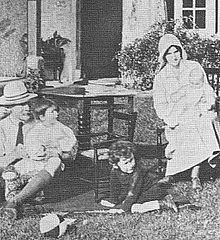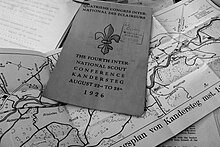Scouting for Boys

Cover of first part of Scouting For Boys, January 1908
|
|
| Author | Robert Baden-Powell |
|---|---|
| Illustrator | Robert Baden-Powell |
| Cover artist | John Hassall |
| Country | United Kingdom |
| Language | English |
| Subject | Scouting |
| Genre | Boy's handbook |
| Published | 24 January 1908 Horace Cox |
| OCLC | 492503066 |
History
Scouting for Boys (1908) was Baden-Powell's rewrite of his earlier book Aids to Scouting (1899) with many youth training ideas openly taken from The Birch Bark Roll of the Woodcraft Indians (1906) written by Ernest Thompson Seton, who later became the Chief Scout of the Boy Scouts of America. Aids to Scouting was mostly a written explanation of the military scouting and self-reliance skills lessons Baden-Powell had learned from Frederick Russell Burnham, the British Army Chief of Scouts, but following the siege of Mafeking this military handbook unexpectedly became popular with many youth groups and educators, like Charlotte Mason, in Britain. At Mafeking, Baden-Powell's adjutant had recruited and trained boys aged 12–15 as cadets and during the siege they acted as postmen, messengers, and later to carry the wounded, to free men for fighting. Upon his return to England, following the Second Boer War, Baden-Powell learned some British schools had been using Aids to Scouting to teach observation and deduction. In 1906, Seton discussed youth training ideas with Baden-Powell and shared with him a copy of The Birch Bark Roll of the Woodcraft Indians.Soon after, Baden-Powell decided to revise Aids to Scouting into a book for boys. Several friends supported Baden-Powell, including Sir William Alexander Smith, founder of the Boys' Brigade, and Cyril Arthur Pearson, who owned newspapers and printing presses. Baden-Powell wrote a draft, then called Boy Patrols, which he used and tested with 22 boys for one week at camp on Brownsea Island in the summer of 1907, where Pearson's literary editor Percy Everett assisted.Scouting for Boys was published in six fortnightly instalments of approximately 70 pages each, from January to March 1908. They were produced by Pearson's printer, Horace Cox. These six publications were a success and, as planned, were issued in book form on 1 May 1908. Although Aids to Scouting strongly influenced the book, Scouting for Boys presents Scouting from the perspective of outdoorsmen and explorers rather than military men, and it adds the Scout Oath, Scout Law, honours and games for youth. The book was revised and an enormous variety of editions were published. Many of these editions were edited by others and, far beyond mere editing, whole sections were written by authors other than Baden-Powell. The book was a best seller upon release, and, in its various editions, is claimed to have become one of the best-selling books in history. Scouting for Boys has been translated into many languages. In 1948, editions of the book were still selling 50,000 copies annually. Only in 1967 was a decline noted by the publisher and in the last decades of the 20th century the book came to be seen as a period curiosity even by the Scout Movement. It is claimed to be the fourth bestselling book of the 20th century. A realistic estimate is that approximately 4 million copies of the UK edition have been sold. Extrapolating this to 87 different language editions worldwide, historic world sales of Scouting for Boys can be estimated at 100 to 150 million copies since 1908.
In her introduction to the 2005 edition, Elleke Boehmer criticises the book saying "the text was deeply scored through with a contemporary class prejudice which would have been off-putting to non-middle-class readers, as captured in the sharp aphorism that bees form a 'model community, for they respect their Queen and kill their unemployed' (p.117) Character observation in many ways meant reading for the signs of working-class poverty."














